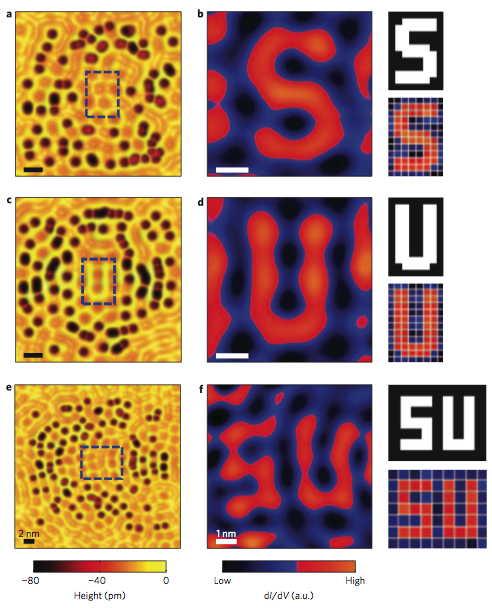Researchers at Stanford University have demonstrated quantum holographic storage, shattering long-held assumptions about the information limits of matter. Moving into the sub-atomic realm, they permanently stored 35 bits in the quantum space surrounding a single electron.
Moreover, the technique allows holograms to be “stacked” in 3 dimensions, enabling 2 35-bit storage elements to occupy the same space. Encoding data using mere atoms would be less than half as space efficient.
Holodeck backstory
Holograms use 2 coherent laser beams – a reference beam and an illumination beam – to create an interference pattern that is recorded on photo sensitive media. Shine a laser on the recorded interference pattern and the original image is reconstructed in glorious 3D. As the laser moves around – or you do – you see the image from different perspectives..
A InPhase Technologies, a spin-off from Bell Labs has been working on commercial holographic storage for several years. They may even be shipping it – who knew?
Quantum holography
The researchers (Christopher R. Moon, Laila S. Mattos, Brian K. Foster, Gabriel Zeltzer and Hari C. Manoharan) an interdisciplinary team from the departments of Physics, Electrical Engineering and Applied Physics at Stanford, used a gas of 2D surface state electrons held on the face of a copper crystal. Using atomic manipulation the team place individual electrons in closed quantum corrals – a common research tool.
The tricky part was encoding a specific pattern around the electrons. Using simulated annealing, they controlled the amplitude and phase of the electrons to encode the bits.

Baseline quantum holography
Since the writing “surface” is a gas, the team was then able to encode holograms in the same space by embedding them volumetrically in 3D. Here’s a picture:

Volumetric holography
A scanning tunneling microscope, a standard tool of atomic level research, was used to read the information and create the images.
iPod sub-Nano
The authors conclude:
We have experimentally demonstrated that 35 bits can be permanently encoded into a time-independent fermionic state, and that two such states can be simultaneously prepared in the same area of space. . . . In all experimental attempts, extending down to the subatomic regime, the encoding was successful and the data were retrieved at 100% ï¬delity. We believe the limitations on bit size are [.025 of a nanometer], but surprisingly the information density can be signiï¬cantly boosted by using higher-energy electrons and stacking multiple pages holographically. Determining the full theoretical and practical limits of this technique — the trade-offs between information content (the number of pages and bits per page), contrast (the number of measurements required per bit to overcome noise), and the number of atoms in the hologram — will involve further work.
I hope they get the money they need to continue this research.
The Storage Bits take
This is far frontiers research – not something you’ll see in a commercial product in 5 years or even 25 years. But by demonstrating that quantum holography can store massive amounts of data in a very small space, the scientists have pushed out our conception of how much data mankind may eventually be able to process and store.
Comments welcome, of course. The complete article is available online at Nature Nanotechnology (pdf).


… sure – as ready and real as InPhase 🙂
To store data is very different to process of course. By process I also mean the human involvement – making use of it all. I tend to feel I already have more data than I can make use of.
What I can see us ending up with is huge amounts of write-only data; essentially data logging on a massive level. There are precedents – just how much of that CCTV “footage” is ever looked at? It will be technically feasible (in storage terms) to record almost every aspect of everybody’s lives at full video level. Even if no government makes it compulsory (and I can imagine them doing it to “offenders”), some company somewhere will produce devices to do this for the mass market. Given the way that people seem prepared to give up privacy on the Internet, then anything could happen. Some Twitter addicts seems prepared to let the world know of what they are up to on an almost minute-by-minute basis. Logging their lives electronically would be a natural move. All this virtually unlimited storage could be welcoming us into somebody else’s goldfish bowl.
It is in the nature of technology that it changes human behaviour in ways that we cannot easily forecast.